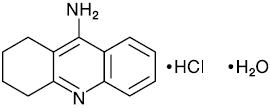Cognex
Generic name:tacrine hydrochloride
Dosage form: capsules
Drug class:Cholinesterase inhibitors
Medically reviewed by Drugs.com. Last updated on Nov 22, 2021.
Cognex®
(Tacrine Hydrochloride Capsules)
Rx Only
Rev. 08/08
Description
Cognex® (tacrine hydrochloride) is a reversible cholinesterase inhibitor, known chemically as 1,2,3,4-tetrahydro-9-acridinamine monohydrochloride monohydrate. Tacrine hydrochloride is commonly referred to in the clinical and pharmacological literature as THA. It has an empirical formula of C13H14N2• HCl • H2O and a molecular weight of 252.74.
The molecular formula of tacrine hydrochloride is:
Tacrine hydrochloride is a white solid and is freely soluble in distilled water, 0.1N hydrochloric acid, acetate buffer (pH 4.0), phosphate buffer (pH 7.0 to 7.4), methanol, dimethylsulfoxide (DMSO), ethanol, and propylene glycol. The compound is sparingly soluble in linoleic acid and PEG 400.
Each capsule of Cognex® contains tacrine as the hydrochloride. Inactive ingredients are hydrous lactose, magnesium stearate, and microcrystalline cellulose. The hard gelatin capsules contain gelatin, NF; silicon dioxide, NF; sodium lauryl sulfate, NF; and the following dyes: 10 mg: D&C Yellow #10, FD&C Green #3, titanium dioxide; 20 mg: D&C Yellow #10, FD&C Blue #1, titanium dioxide; 30 mg: D&C Yellow #10, FD&C Blue #1, FD&C Red #40, titanium dioxide; 40 mg: D&C Yellow #10, FD&C Blue #1, FD&C Red #40, D&C Red #28, titanium dioxide.
Each 10-, 20-, 30-, and 40-mg Cognex® capsule for oral administration contains 12.75, 25.50, 38.25, and 51.00 mg of tacrine HCl, respectively.
On This Page
Cognex - Clinical Pharmacology
Although widespread degeneration of multiple CNS neuronal systems eventually occurs, early pathological changes in Alzheimer's Disease involve, in a relatively selective manner, cholinergic neuronal pathways that project from the basal forebrain to the cerebral cortex and hippocampus. The resulting deficiency of cortical acetylcholine is believed to account for some of the clinical manifestations of mild to moderate dementia. Tacrine, an orally bioavailable, centrally active, reversible cholinesterase inhibitor, presumably acts by



